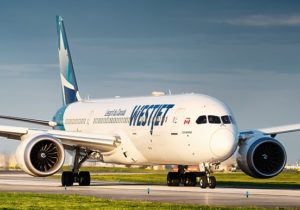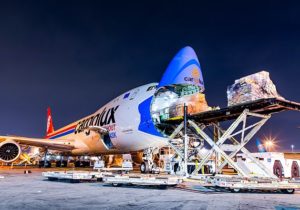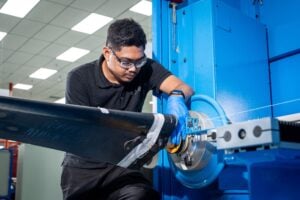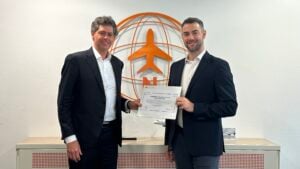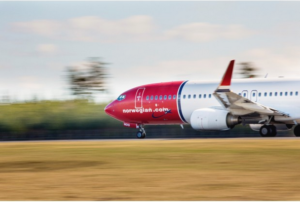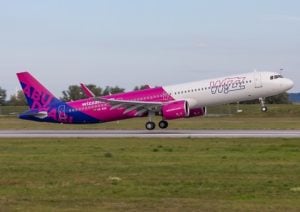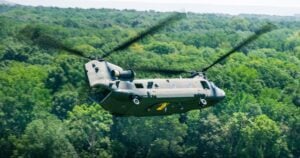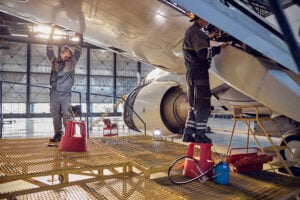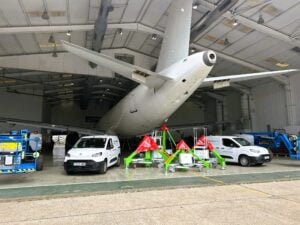repair or replace?
By David Dundas
For MROs, there is the constant challenge of whether a part can be repaired, or if it needs to be replaced either with a brand-new part or USM. The dilemma becomes increasingly more challenging when it comes to the critical area of aircraft engines which are subject to forces that other parts of an aircraft are not subject to. We wanted to learn more about the ‘tipping point’, that point where it may not be economically viable to repair a damaged or worn engine part as opposed to replacing it. We are fortunate to have been in contact with four respected companies who have a wealth of knowledge when it comes to engine MRO and they have been kind enough to supply us with a great deal of interesting information on the frequent challenge of deciding whether a rejected engine part should be replaced or repaired.
Identifying primary criteria to be considered when deciding if a rejected engine part should be repaired or replaced
While everyone takes into account the actual cost of repairs to a rejected part, it soon becomes apparent there is a lot more to be considered when deciding whether or not to repair or replace an engine part. For example, Oliver Boro, Technical Consultant for Engines at AMROS Global point makes a very valid point with regard to any replacement parts when he advises that: “… the replacement components necessary for repairing or overhauling the part should be available,” while Chris Lund, Director Operations at StandardAero’s Center of Excellence (COE) for Turboprop Engine MRO, points out that from his perspective: “This decision is generally based on a combination of engine original equipment manufacturer (OEM) criteria, OEM commercial support program availability, and assessment of market value versus repair cost.”
Valentins Iljins – Power Plant Lead Engineer at Vallair looks far beyond the basic cost of repairs versus value scenario and introduces the relevance of time factors. He comments that: “At Vallair we consider a variety of criteria when determining whether a rejected engine part should be repaired or replaced such as market availability, catalogue price for the new part (similar part or any modification of the part), used market cost for the part and repair capabilities, average cost, and lead time. Plus, time allowance is considered if there is a waiting time to get the part repaired and it would be better to replace the part so that the engine and/or aircraft can be released back to service.” Going into even further detail, Desean Palmer, Senior Director Material Management at VAS Aero Services advises that beyond looking at every situation on a case-by-case basis, four of the key factors to consider are current and future market demands of the specific part number and the average repair and recertification investment cost compared to the cost of replacing the part at current market rates. He also includes current MRO shop capacity and average lead-times, and work scope requirements to fully service a part and have it recertified.
Which engine part types are most commonly rejected?
It is fair to say that because of their very purpose, some engine parts will likely wear out or require repairs more often than others. Chris Lund is very precise and concise, identifying bearings, blades and hot section vanes/stators as the ‘prime culprits’. Valentins Iljins is pretty much of the same opinion as Lund in mentioning high-pressure turbine (HPT) blades, and HPT nozzle guide vanes. However, he goes on to explain that these are parts related to the hot section of an engine and the causes of part rejection are as a consequence of: “fatigue and extreme thermal or mechanical stresses leading to cracks, pits, degradation, and other types of failure of the material.”
Desean Palmer shares similar opinions as Lund and Iljins, identifying factors that can lead to part failure/rejection to include: “… total time on wing, operating environments, and level of work previously performed (if applicable).” However, he then goes on to explain that: “From our experience disassembling engines for USM re-sale and frequently investing in USM packages, parts with higher-than-average scrap rates include the hot sections (modules) within the engine (i.e., High-Pressure Turbine) and the High-Pressure Compressor (HPC) also is frequently subject to rejection due to increased stages of material and rotating parts throughout this section of the engine.” Meanwhile, Oliver Boro is particularly focused on blades, and he points out that: “… the components most commonly rejected are the blades from both the compressor and the turbine section. The blades are exposed to high rotational speeds, vibrations, high temperatures (turbine section), and foreign object damage (compressor section). Approximately twelve percent of the blades in a typical, moderately aged commercial engine are classified as non-repairable during routine overhaul. The higher blade rejection rate is typical for Stage 1.”
Does the availability of USM influence the decision to replace or repair a rejected part?
Let’s face it, many ‘replace or repair’ MRO decisions can rest on whether or not replacement parts are available, irrespective of whether or no they are brand new or USM. Valentins Iljins is unequivocal where Vallair is concerned, stating that: “The availability of used serviceable material (USM) highly influences the decision whether to repair or replace a part. This is because if used material is available and the price is cheaper without reliability loss, the priority of a fast solution quickly becomes a determining factor.” Desean Palmer agrees with Iljins, but goes into greater detail, particularly in relation to what has been happening more recently. “When parts are widely available in the USM market, replacement units may be the best, most cost-effective solution rather than making heavy investments in the repair and incurring long lead-time delays at the shop. However, during the last couple of years, supply chain backlogs have impacted the market for both newly manufactured and USM critical engine parts. New OEM parts have exceptionally long lead times and USM is in short supply or, depending on the part, simply unavailable. For this reason, repair investment may be the most economical path even when factoring in longer lead-times for the repair cycle,” he comments.
Oliver Boro concurs with Iljins and Palmer, in particular when it comes to reducing time needed for maintenance and repair, stating that: “With readily available USM, we can avoid lengthy repair processes or waiting for new parts to be sourced. This helps minimize aircraft downtime and allows quicker turnaround times. USM parts undergo thorough inspections, repairs, and testing to meet the required airworthiness standards.” Beyond the opinions given above, Chris Lund also makes a very valid point that: “… the cycles/hours remaining for USM parts will be considered when making a decision.”
The lifespan and long-term reliability of a repaired part compared to a new replacement
While there are many other factors that can heavily influence the decision of whether or not to repair or replace an engine part, the lifespan of the new part has to be a key factor. After all, a repaired part or USM might last only 30% as long as a brand-new replacement part, but if the repair costs are only 10% of the cost of that replacement, and the downtime is not excessive, repairing makes financial sense. Chris Lund, the Director of Operations, at StandardAero’s Center of Excellence (COE) for Turboprop Engine MRO explains further: “The long-term reliability of a repaired part is initially predicted through design analysis/modelling undertaken during the development of the repair scheme, and subsequently validated as engines incorporating the repaired part are inducted for maintenance/overhaul and inspected.”
Valentins Iljins at Vallair makes an extremely interesting observation with regard to repaired part reliability, stating that: “… we focus on maximising the life and value of aircraft, engines, and parts. Our experience shows that properly repaired used parts often last longer and are more reliable than new parts. Additionally, new parts can be significantly more expensive, and the lead time for delivery could be extensive.” Meanwhile at VAS Aero Services, Desean Palmer is keen to point out that depending on the engine model type, for current-generation engines the repair work scope that was performed can be a sound measure of long-term reliability, with unique repairs extending the life of the part. He adds that “The advancement of parts inspection and test technologies also has allowed the market to conduct improved (and more reliable) high-level assessments on parts to better forecast their serviceable life.”
As AMROS Global’s Oliver Boro points out, USM parts can significantly reduce the time required for maintenance and repairs. He then further explains that: “With readily available USM, we can avoid lengthy repair processes or waiting for new parts to be sourced. This helps minimise aircraft downtime and allows quicker turnaround times. USM parts undergo thorough inspections, repairs, and testing to meet the required airworthiness standards.”
When a repair can be financially beneficial in the short term, but not the long term
With continual supply chain issues, there are always going to be unforeseen situations where it will be cheaper to repair a part if it means keeping an aircraft operational because there is a shortage of new parts. The repair can be seen as financially astute as a stop-gap measure while a new part is on order, ensuring that when the repaired part is once again rejected, there is a replacement part immediately on hand. However, there are other more specific instances where a short-term repair still makes financial sense. This is highlighted by Valentins Iljins where he points out that: “There are scenarios where repairing a part is more cost-effective for the short term such as a fuel metering unit which is installed on a V2500 engine. There is a common problem with fuel leaks and the only way to fix this is to make a modification to the latest configuration. However, to embody that modification is extremely costly. So, sometimes it is better to repair FMU or replace it from the market with the pre-modification made and it will last a long time on-wing without fuel leaks. Thereby meeting your operational targets until the aircraft is returned back from lease for example.”
Oliver Boro adopts a more pragmatic approach to the situation, commenting that: “Opting for a quick repair might seem like a cost-effective solution in the short term, but it could cost more in the long run if the asset continues to fail. As an example for short-term repair, we can consider the Boroblending repair technique which solves the problem through mechanical repair of compressor blades damaged by domestic or foreign objects. Boroblending could be performed in a few hours, cost much less and prolong the engine’s safe usage.” Alternatively, Desean Palmer feels that there are short-term cost savings, but that repair may very well impact the part’s longer-term use and residual value. However, he goes on to reveal that: “Many companies are looking at more cost-effective repair methods such as Designated Engineering Representative (DER) repairs and the use of Parts Manufacturer Approval (PMA) materials. These methods realise short-term cost benefits but can affect the part’s marketability over the long term.” To round off, Chris Lund comes up with a very clear example where there is a short-term saving with a repair, but one which is not beneficial in the long term. He explains: “Hot section vanes and stators can be an example where money saved up front through a repair might end up being offset by the part having a shorter operational life, though there are often other factors that can affect this calculation, such as fuel nozzle condition and operating environment.”






